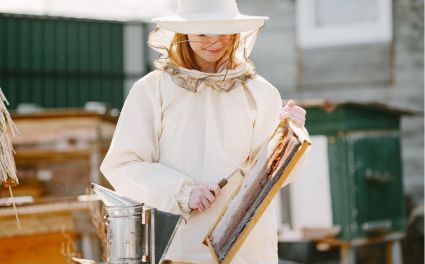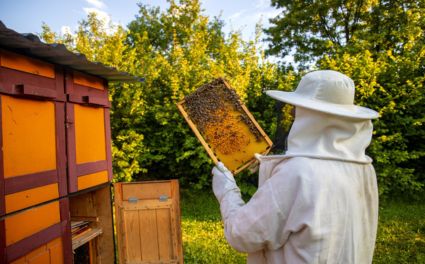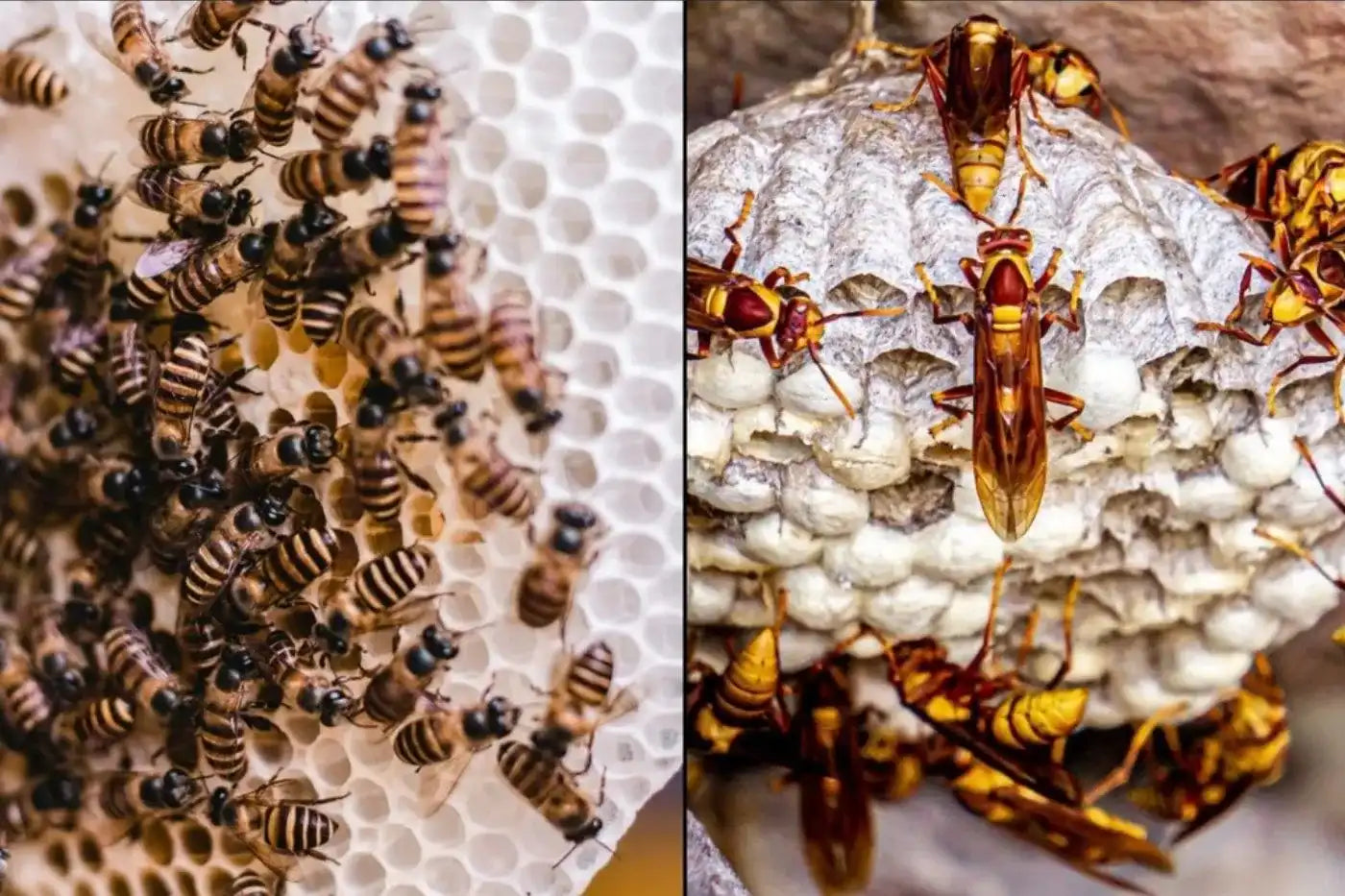Bee nests and wasp nests are two distinct marvels of the insect world, each showcasing intricate architectural designs and serving unique ecological purposes. Bees and wasps have important roles in their habitats, but they have different characteristics in terms of how they build their homes, where they live, and their impact on the environment. These differences highlight how bees and wasps have adapted to different ecosystems and contribute to the overall balance of nature. It is important to understand the differences between these nests in order to fully appreciate the ecological importance of these insect populations.
Bee Nest
Bee nests, also known as hives, have a well-organized and detailed structure. A bee nest is usually made up of hexagonal cells made of beeswax. These cells are arranged in vertical combs within the nest. The combs in the hive are arranged in layers with gaps between them to make it easier for the bees to move around. Bees collect propolis from plants and use it to create layers around the outside of their nest. This propolis acts as a protective barrier, keeping the nest safe from outside dangers and helping to regulate the temperature inside.
Components of a Bee Nest, Including Combs and Cells
A bee nest consists mainly of combs and cells. Combs are structures used by bees to raise their young and store honey and pollen. The cells in the combs have different purposes. Larger cells are used for raising drones and storing pollen, while smaller cells are used for raising worker bees. Worker bees carefully create and maintain these cells to support the healthy growth of the brood and store resources effectively.
Honey Storage and Larval Development within Bee Nests
Bee nests are important for various activities, such as storing honey and developing larvae. Bees gather nectar from flowers and store it in cells. Through enzymatic actions and evaporation, the nectar is transformed into honey. The combs store an important food source that is essential for the colony's survival when there is a shortage. The cells also contain the queen's eggs, which later become larvae. Worker bees take care of the larvae by feeding them and creating the perfect environment for their growth. This continues until the larvae transform into adult bees. The bee nest plays a crucial role in supporting the life cycle and ongoing existence of the bee colony. This process is cyclical.
Also read: Why do bees make honey?
Wasp Nest
Wasp nests can have different forms, and species of wasps have their unique nesting behaviors. Paper wasps build open, umbrella-shaped nests that are usually found in protected spots like eaves or tree branches. They make these nests using a papery material made from wood fibers mixed with their saliva. Hornet nests are usually round and made by hornets. They are built using chewed wood pulp, which creates a paper-like material. The nests are known for their intricate and layered structure. Certain types of wasps, like mud daubers, construct nests using mud. These nests are shaped like cylinders and serve as a home for their offspring.
Analysis of the Material Used in Building Wasp Nests
The material used to build wasp nests can vary depending on the species and their nesting preferences. Paper wasps use a mixture of wood fibers, plant matter, and saliva to build their nests, which have a unique papery texture. Hornets and yellow jackets build their nests using chewed wood pulp mixed with their saliva. These nests have multiple layers and intricate internal structures. Mud daubers are insects that build nests using mud. They create cylindrical nests and attach them to walls or ceilings in protected areas.
Roles of Various Sections within a Wasp Nest, Including the Combs and Chambers
Wasp nests have different sections that serve important functions for the survival and development of the colony. Wasps use combs in their nests to raise their young. Each larva or pupa has its chamber. The nest also has sections for storing food, like prey caught by the wasps or nectar collected by worker wasps. The outer layers of the nest protect the inner parts from outside dangers and create a stable environment for the colony to grow and stay healthy.
Also read: Structures and Functions of Honeycomb and Beehive
Contrasting Features
Bees and wasps have different preferences for where they build their nests. Bees are known for building their hives in protected areas like tree cavities, rock crevices, or man-made hives. They prefer locations that offer them shelter from the weather and protection from predators. Wasps build nests in different places. Some species like to build nests in the air, such as under eaves, on tree branches, or shrubs. Other species prefer to build nests on the ground by burrowing into the soil or using abandoned rodent burrows. The differences in where bees and wasps build their nests are a result of their various ecological roles and adaptations to their surroundings.
Differences in the Architectural Design and Construction Techniques
Bee and wasp nests have distinct architectural designs and construction techniques. Bee nests are known for their hexagonal combs and wax construction. They have a well-organized layout that promotes efficiency and optimal use of resources. Wasp nests come in a variety of architectural designs. Some species create papery nests with open combs, while others build multi-layered nests with intricate internal structures. Wasp nests are made from materials like wood pulp, plant fibers, or mud. This shows how adaptable and resourceful wasps are in building nests that suit their nesting habits and environment.
Ecological Significance
Bee and wasp nests play an important role in local ecosystems. They contribute to the ecological dynamics and biodiversity of their habitats. Bee nests are important for pollination. They help plants reproduce and support the growth of different types of plants that are important for the stability of the ecosystem. In addition, honey produced by bees is a source of food for many other organisms, which helps to enhance the local food web. Wasp nests are beneficial for pest control because many species of wasps eat other insects. This helps to keep insect populations in balance within their ecosystems. Wasp nesting habits affect nutrient cycling. They scavenge and decompose organic matter, helping to break down and recycle materials in their environment.
Also read: Evaluating The Effectiveness Of Bee Suits In Wasp Defense
Role of Both Nests in Maintaining Ecological Balance and Biodiversity
Bee and wasp nests play a crucial role in maintaining ecological balance and promoting biodiversity in ecosystems. Bees play a crucial role in pollination, which helps different plants grow. This leads to a diverse and strong plant community, which is important for many land ecosystems. Wasps' predatory behavior is beneficial because it helps control pest populations. This prevents certain insect species from becoming too numerous and disrupting the balance in the ecosystem. Both nests are important for the health and sustainability of their habitats. This shows how different species in an ecosystem are connected and highlights the significance of these often overlooked insect populations in maintaining ecological balance and biodiversity.
Final Thoughts
Bee nests and wasp nests are examples of the architectural abilities shown by these important insect species. Bees are known for their well-made honeycombs and effective use of resources. They build intricate nests that help their colonies survive and reproduce. Wasps have different nesting behaviors and can build different types of structures, such as papery open combs or intricate multi-layered nests. This shows that they are able to adapt to different environments.
Bee and wasp nests have different nesting patterns and construction techniques. These differences are important because they show how bees and wasps have unique roles in their ecosystems. The way they build their nests affects how they interact with their surroundings. It is important to understand these differences in order to comprehend how insect communities function in the natural world.



